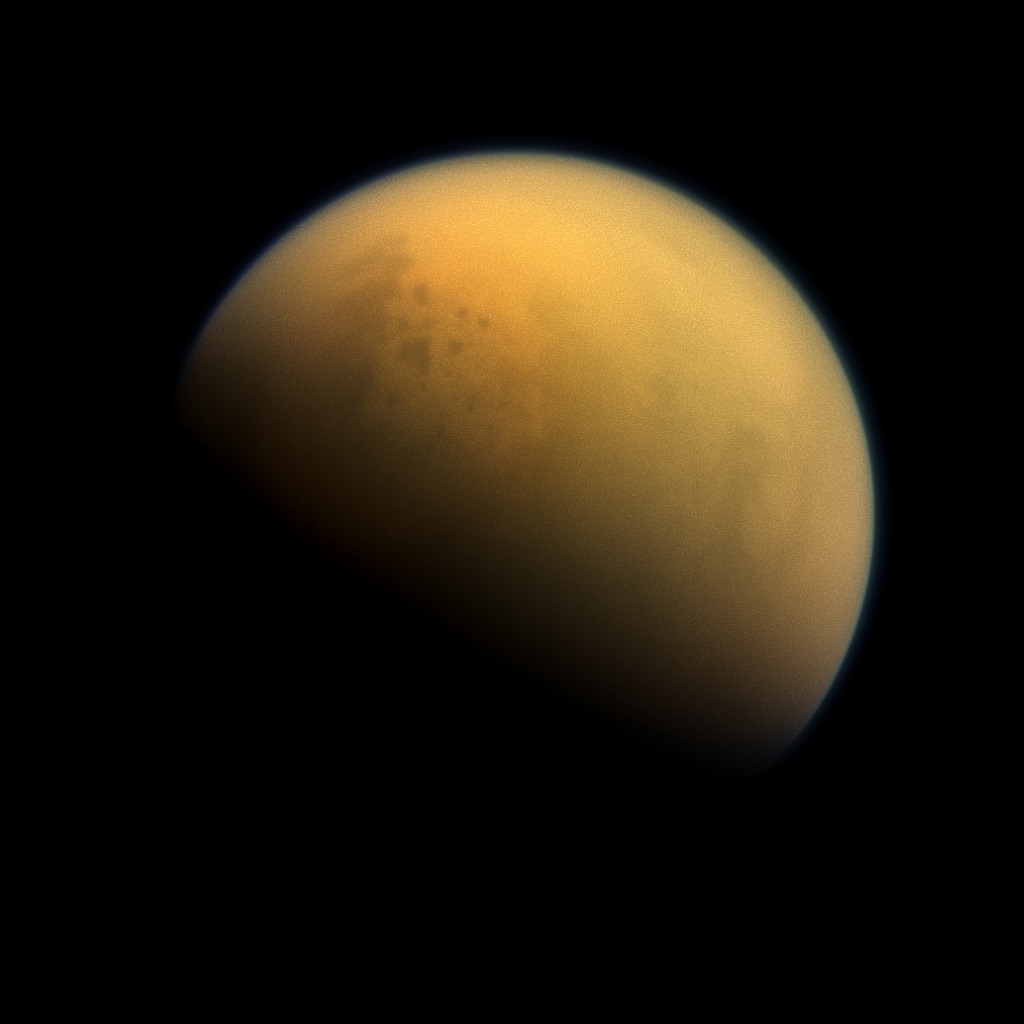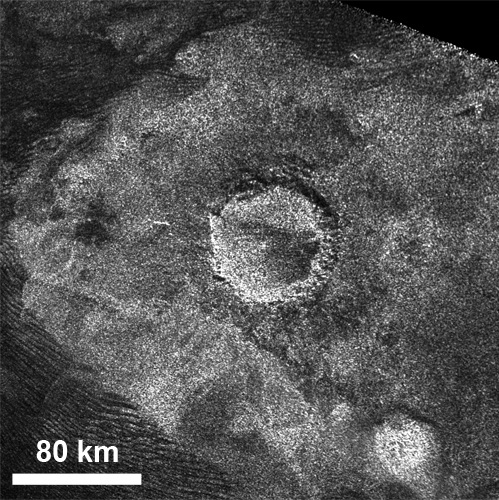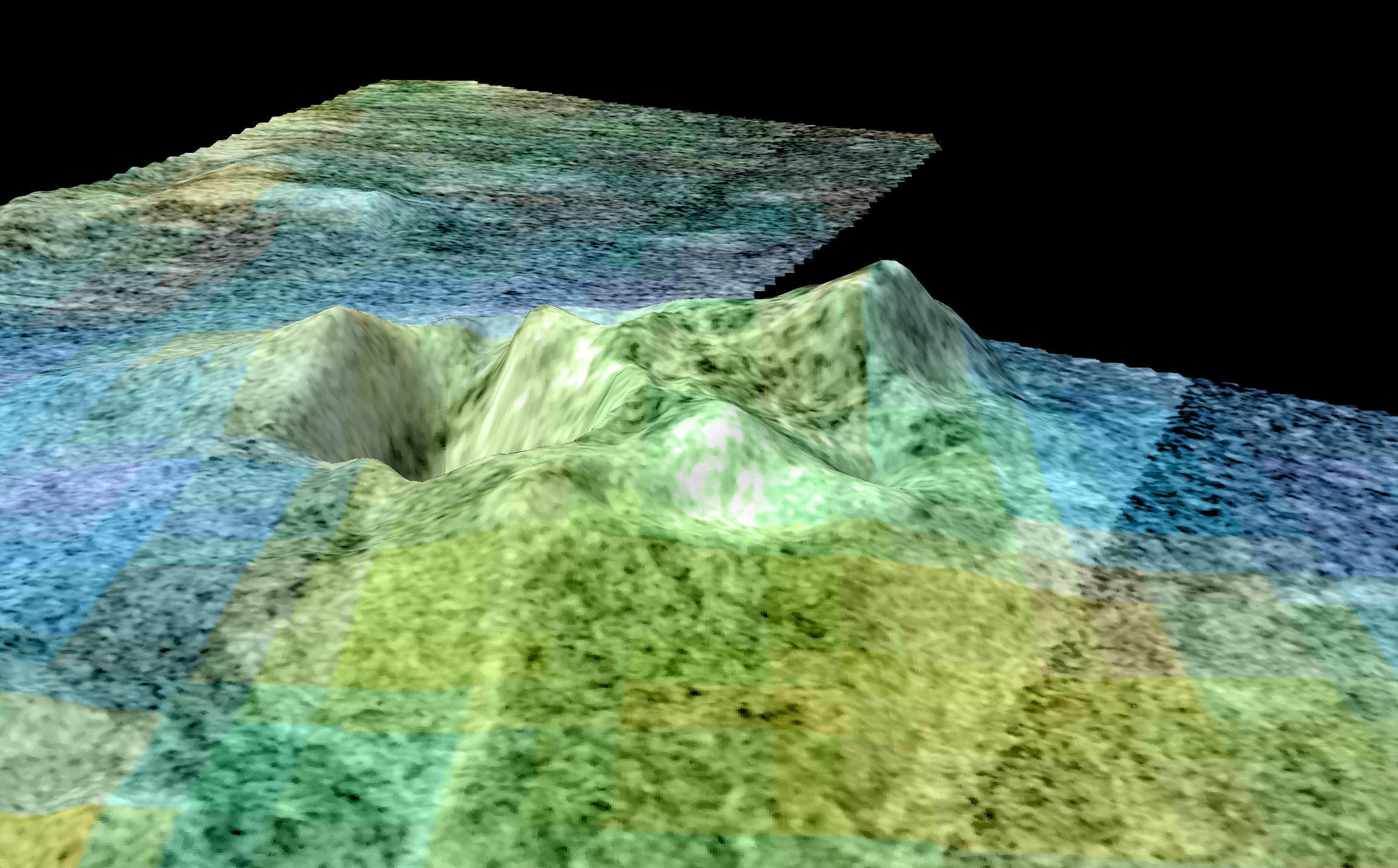Where to Search for Signs of Life on Titan

New findings, published in the journal Astrobiology, suggest that large craters are the prime locations in which to find the building blocks of life on Saturn's largest moon, Titan.
Titan is an icy expanse covered by organic molecules, with liquid methane lakes enshrouded by a thick, hazy atmosphere of nitrogen and methane that begs the question: why isn't there life on this strangely Earth-like world? Perhaps it is the balmy -179 degrees Celsius (-300 degrees Fahrenheit) temperature on the surface that would likely prevent any biochemical reactions from taking place. But is there any place on Titan where there might be hope that biomolecules, such as amino acids, could form? One team wanted to find out.
Using imagery and data from the Cassini spacecraft and Huygens probe, scientists led by Dr Catherine Neish, a planetary scientist specializing in impact cratering at the University of Western Ontario, went on a hunt for the best places to look for biological molecules on the surface of Titan. Life, as we know it, is carbon-based and uses liquid water as a solvent. The surface of Titan has abundant carbon-rich molecules (hydrocarbons) that have been shown to form amino acids, the building blocks of proteins needed for life, when exposed to liquid water in laboratory simulations. [Dazzling Views Show Saturn Moon Titan's Surface Like Never Before]
Herein lies the problem: Titan is much too cold for liquid water to be present on the surface. Although this is not a favorable scenario for life-bearing molecules to form, there is hope.
Erasing craters
Radar measurements from Cassini, which orbited Saturn for 13 years, were able to peer through Titan's optically thick atmosphere, revealing the terrain of this enigmatic world. What was revealed was unexpected — Titan is active. Cassini's radar instrument unveiled lakes, dunes, mountains, river valleys, and not many craters, indicating that there are processes happening that resurface Titan and either fill in or erode older craters. Discovering a similar world to Earth over nine times its distance from the Sun was monumental.
With such a familiar landscape to Earth, where would be the best places to look for signs of life? Although the methane lakes may have seemed like the obvious choice, Neish and her colleagues instead found craters and cryovolcanoes (regions where liquid water erupts from beneath Titan's icy surface) to be the two most enticing locations. Both features hold promise for melting Titan's icy crust into liquid water, a necessary step to form complex biomolecules.
Dr Morgan Cable, a technologist in the Instrument Systems Implementation and Concepts Section at NASA's Jet Propulsion Laboratory, in Pasadena, California, is an expert in 'tholins' (organics produced when simple gas mixtures are subject to cosmic radiation). She commented, "when we mix tholins with liquid water we make amino acids really fast. So any place where there is liquid water on Titan's surface or near its surface could be generating the precursors to life — biomolecules — that would be important for life as we know it, and that's really exciting."
Get the Space.com Newsletter
Breaking space news, the latest updates on rocket launches, skywatching events and more!

Craters are best
With both cryovolcanoes and craters as literal hot spots for melting on Titan, which feature is the one that you should bet your money on? For Neish, the answer is unequivocally craters, despite there not being as many on Titan as there are on our Moon.
"Craters really emerged as the clear winner for three main reasons," Neish tells Astrobiology Magazine. "One, is that we're pretty sure there are craters on Titan.
Cratering is a very common geologic process and we see circular features that are almost certainly craters on the surface," she says.
The second point is that craters would likely generate more melt than a cryovolcano, meaning that "they take longer to freeze so [the water] will stay liquid for longer," says Neish, adding that liquid water is key for complex chemical reactions to take place. [Does Titan's Hydrocarbon Soup Hold A Recipe for Life?]
"The last point is that impact craters should produce water that's at a higher temperature than a cryovolcano," says Neish. Hotter water means faster chemical reaction rates, which holds promise for the creation of life-bearing molecules.
"Water could stay liquid in those environments for thousands of years, or even longer," says Cable.
Cryovolcanoes, on the other hand, are not so hot. "When a cryovolcano erupts, it typically erupts right at the melting temperature of the ice, and we think any 'lava' [in this case, a slushy form of water] on Titan would be heavily doped with ammonia, which suppresses the freezing point quite a bit so that would make the lava pretty cold," says Neish.
To put the final nail into the coffin for these icy volcanoes', cryovolcanism turns out to be a more obscure and elusive process. Imagine ice, which is less dense than water, floating in a glass of water. "Trying to get the water up on the top of the ice is quite difficult when you have a density contrast like that," says Neish. "Cryovolcanism is the harder thing to do and there is very little evidence of it on Titan."
In fact, cryovolcanism might not even be real on Titan. "Sotra Facula [a mountainous feature on Titan that appears to have a caldera-like depression] is perhaps the best and only example that we have of a cryovolcano on Titan." adds Neish. "So it's much rarer, if it exists at all."

In situ measurements
Sinlap (112 kilometers/70 miles in diameter), Selk (90 kilometers/56 miles), and Menrva (392 kilometers/244 miles) craters, which are the largest fresh craters on Titan, are prime locations in which to look when we finally have the capabilities to search for biomolecules in these craters. A probe would need to land on Titan and take in situ measurements to make such a discovery. But are these targets the next candidates for a future Titan mission? Not everyone is convinced.
"We don't know where to search even with results like this," says Dr. David Grinspoon, a Senior Scientist at the Planetary Science Institute. "I wouldn't use it to guide our next mission to Titan. It's premature." [Saturn's Moon Titan May Have Earth-Like 'Sea Level']
Instead, Grinspoon wants to sniff out more places on Titan. "Because there is so little that we actually know about the planet, it makes more sense to characterize a range of environments first," he says.
Nevertheless, although Titan is perplexing, the search for life's building blocks on this frigid world needs to start somewhere and the result of this research gives us not one, but three potential candidates for where to start that search, with hopefully many more to come.
The work was partly supported through the Planetary Data Archiving, Restoration, and Tools (PDART) program. NASA Astrobiology provides resources for this and other Research and Analysis programs within the NASA Science Mission Directorate (SMD) that solicit proposals relevant to astrobiology research.
This story was provided by Astrobiology Magazine, a web-based publication sponsored by the NASA astrobiology program. This version of the story published on Space.com. Follow us @Spacedotcom, Facebook or Google+.
Join our Space Forums to keep talking space on the latest missions, night sky and more! And if you have a news tip, correction or comment, let us know at: community@space.com.










